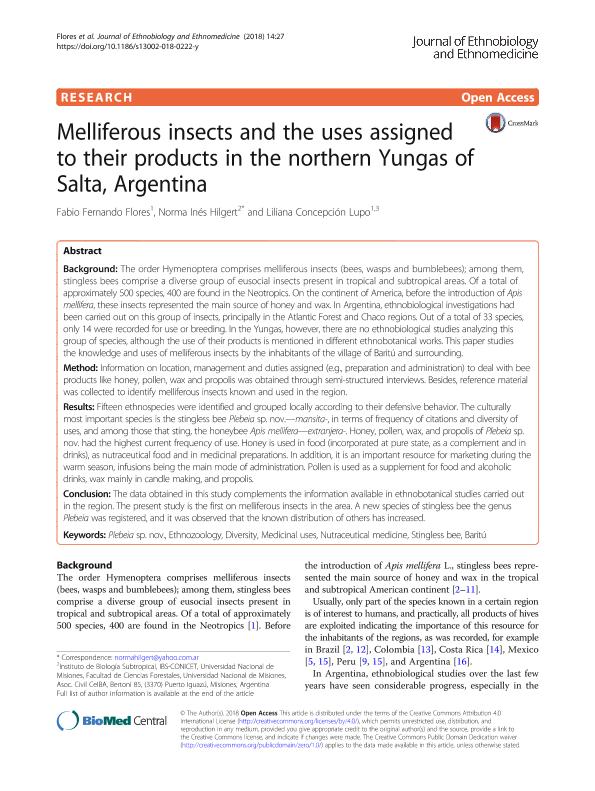Mostrar el registro sencillo del ítem
dc.contributor.author
Flores, Fabio Fernando

dc.contributor.author
Hilgert, Norma Ines

dc.contributor.author
Lupo, Liliana Concepcion

dc.date.available
2019-12-10T16:49:20Z
dc.date.issued
2018-04
dc.identifier.citation
Flores, Fabio Fernando; Hilgert, Norma Ines; Lupo, Liliana Concepcion; Melliferous insects and the uses assigned to their products in the northern Yungas of Salta, Argentina; BioMed Central; Journal of Ethnobiology and Ethnomedicine; 14; 1; 4-2018; 1-15
dc.identifier.issn
1746-4269
dc.identifier.uri
http://hdl.handle.net/11336/91895
dc.description.abstract
Background: The order Hymenoptera comprises melliferous insects (bees, wasps and bumblebees); among them, stingless bees comprise a diverse group of eusocial insects present in tropical and subtropical areas. Of a total of approximately 500 species, 400 are found in the Neotropics. On the continent of America, before the introduction of Apis mellifera, these insects represented the main source of honey and wax. In Argentina, ethnobiological investigations had been carried out on this group of insects, principally in the Atlantic Forest and Chaco regions. Out of a total of 33 species, only 14 were recorded for use or breeding. In the Yungas, however, there are no ethnobiological studies analyzing this group of species, although the use of their products is mentioned in different ethnobotanical works. This paper studies the knowledge and uses of melliferous insects by the inhabitants of the village of Baritú and surrounding. Method: Information on location, management and duties assigned (e.g., preparation and administration) to deal with bee products like honey, pollen, wax and propolis was obtained through semi-structured interviews. Besides, reference material was collected to identify melliferous insects known and used in the region. Results: Fifteen ethnospecies were identified and grouped locally according to their defensive behavior. The culturally most important species is the stingless bee Plebeia sp. nov.-mansita-, in terms of frequency of citations and diversity of uses, and among those that sting, the honeybee Apis mellifera-extranjera-. Honey, pollen, wax, and propolis of Plebeia sp. nov. had the highest current frequency of use. Honey is used in food (incorporated at pure state, as a complement and in drinks), as nutraceutical food and in medicinal preparations. In addition, it is an important resource for marketing during the warm season, infusions being the main mode of administration. Pollen is used as a supplement for food and alcoholic drinks, wax mainly in candle making, and propolis. Conclusion: The data obtained in this study complements the information available in ethnobotanical studies carried out in the region. The present study is the first on melliferous insects in the area. A new species of stingless bee the genus Plebeia was registered, and it was observed that the known distribution of others has increased.
dc.format
application/pdf
dc.language.iso
eng
dc.publisher
BioMed Central

dc.rights
info:eu-repo/semantics/openAccess
dc.rights.uri
https://creativecommons.org/licenses/by/2.5/ar/
dc.subject
BARITÚ
dc.subject
DIVERSITY
dc.subject
ETHNOZOOLOGY
dc.subject
MEDICINAL USES
dc.subject
NUTRACEUTICAL MEDICINE
dc.subject
PLEBEIA SP. NOV.
dc.subject
STINGLESS BEE
dc.subject.classification
Otras Ciencias Biológicas

dc.subject.classification
Ciencias Biológicas

dc.subject.classification
CIENCIAS NATURALES Y EXACTAS

dc.title
Melliferous insects and the uses assigned to their products in the northern Yungas of Salta, Argentina
dc.type
info:eu-repo/semantics/article
dc.type
info:ar-repo/semantics/artículo
dc.type
info:eu-repo/semantics/publishedVersion
dc.date.updated
2019-10-17T16:27:29Z
dc.journal.volume
14
dc.journal.number
1
dc.journal.pagination
1-15
dc.journal.pais
Países Bajos

dc.description.fil
Fil: Flores, Fabio Fernando. Consejo Nacional de Investigaciones Científicas y Técnicas. Centro de Investigaciones y Transferencia de Jujuy. Universidad Nacional de Jujuy. Centro de Investigaciones y Transferencia de Jujuy; Argentina. Universidad Nacional de Jujuy. Facultad de Ciencias Agrarias; Argentina
dc.description.fil
Fil: Hilgert, Norma Ines. Consejo Nacional de Investigaciones Científicas y Técnicas. Centro Científico Tecnológico Conicet - Nordeste. Instituto de Biología Subtropical. Universidad Nacional de Misiones. Instituto de Biología Subtropical; Argentina. Centro de Investigaciones del Bosque Atlántico; Argentina
dc.description.fil
Fil: Lupo, Liliana Concepcion. Instituto de Ecorregiones Andinas. Consejo Nacional de Investigaciones Científicas y Técnicas. Centro Científico Tecnológico Conicet - Salta. Instituto de Ecorregiones Andinas; Argentina; Argentina. Universidad Nacional de Jujuy. Facultad de Ciencias Agrarias; Argentina
dc.journal.title
Journal of Ethnobiology and Ethnomedicine
dc.relation.alternativeid
info:eu-repo/semantics/altIdentifier/url/https://ethnobiomed.biomedcentral.com/articles/10.1186/s13002-018-0222-y
dc.relation.alternativeid
info:eu-repo/semantics/altIdentifier/doi/http://dx.doi.org/10.1186/s13002-018-0222-y
Archivos asociados
